The daughter in search of a usable past. Ma hi omeret? What does she say?
“Why didn’t the Torah count women among the ‘600,000 men on foot, aside from children,’ who came out of Egypt? And why did Moses say at Sinai, ‘Go not near a woman,’ addressing only men, as if preparation for Revelation was not meant for us, as well?”
Because she already understands that Jewish memory is essential to our identity, teach her that history is made by those who tell the tale. If Torah did not name and number women, it is up to her to fill the empty spaces of our holy texts.
And the daughter who wants to erase her difference. Ma hi omeret? What does she say?
“Why must you keep pushing your women’s questions into every text? And why are these women’s issues so important to you?”
“To you,” and “not to me.” Since she so easily forgets the struggles of her mothers and sisters, you must tell her the story of your own journey to the seder table and invite her to join you in thanking God for the blessing of being a Jewish woman.
And the daughter who does not know that she has a place at the table. Ma hi omeret? What does she say?
“What is this?”
Because she doesn’t realize that her question is, in itself, a part of the seder tradition, teach her that the haggadah is an extended conversation about liberation, and tell her that her insights and questions are also text.
And the daughter who asks no questions?
You must say to her, “Your questions, when they come, will liberate you from Egypt. This is how it is and has always been with your mothers and grandmothers. From the moment Yocheved, Miriam, and the midwives questioned Pharaoh’s edict until today, every question we ask helps us leave Egypt farther behind.”
The Journey Continues: The Ma’yan Haggadah can be purchased for $12 + $4 s/h by emailing Ma’yan, infomayan@mayan.org.
Excerpted from The Journey Continues: The Ma’yan Haggadah (Ma’yan, 2000).












